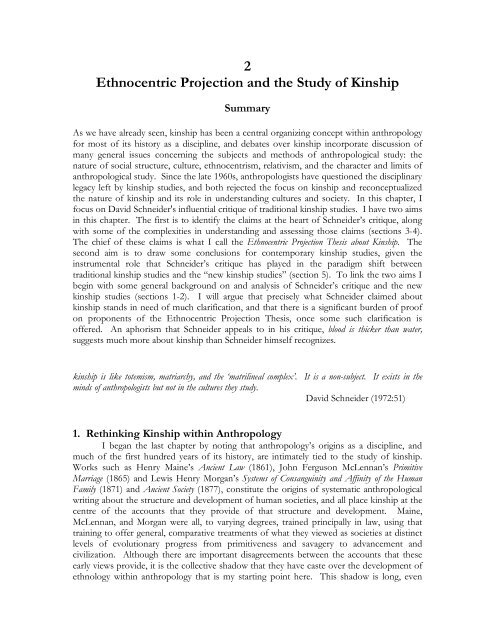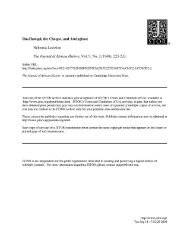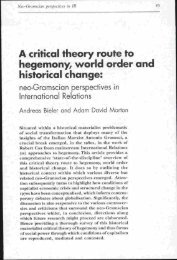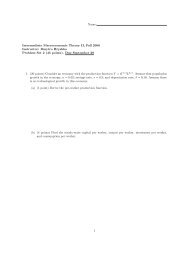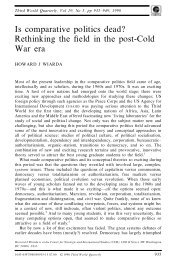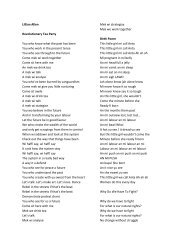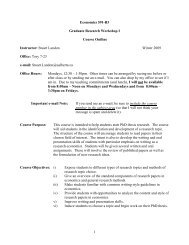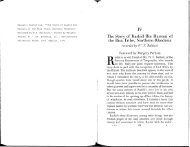2 Ethnocentric Projection and the Study of Kinship
2 Ethnocentric Projection and the Study of Kinship
2 Ethnocentric Projection and the Study of Kinship
Create successful ePaper yourself
Turn your PDF publications into a flip-book with our unique Google optimized e-Paper software.
2<br />
<strong>Ethnocentric</strong> <strong>Projection</strong> <strong>and</strong> <strong>the</strong> <strong>Study</strong> <strong>of</strong> <strong>Kinship</strong><br />
Summary<br />
As we have already seen, kinship has been a central organizing concept within anthropology<br />
for most <strong>of</strong> its history as a discipline, <strong>and</strong> debates over kinship incorporate discussion <strong>of</strong><br />
many general issues concerning <strong>the</strong> subjects <strong>and</strong> methods <strong>of</strong> anthropological study: <strong>the</strong><br />
nature <strong>of</strong> social structure, culture, ethnocentrism, relativism, <strong>and</strong> <strong>the</strong> character <strong>and</strong> limits <strong>of</strong><br />
anthropological study. Since <strong>the</strong> late 1960s, anthropologists have questioned <strong>the</strong> disciplinary<br />
legacy left by kinship studies, <strong>and</strong> both rejected <strong>the</strong> focus on kinship <strong>and</strong> reconceptualized<br />
<strong>the</strong> nature <strong>of</strong> kinship <strong>and</strong> its role in underst<strong>and</strong>ing cultures <strong>and</strong> society. In this chapter, I<br />
focus on David Schneider's influential critique <strong>of</strong> traditional kinship studies. I have two aims<br />
in this chapter. The first is to identify <strong>the</strong> claims at <strong>the</strong> heart <strong>of</strong> Schneider’s critique, along<br />
with some <strong>of</strong> <strong>the</strong> complexities in underst<strong>and</strong>ing <strong>and</strong> assessing those claims (sections 3-4).<br />
The chief <strong>of</strong> <strong>the</strong>se claims is what I call <strong>the</strong> <strong>Ethnocentric</strong> <strong>Projection</strong> Thesis about <strong>Kinship</strong>. The<br />
second aim is to draw some conclusions for contemporary kinship studies, given <strong>the</strong><br />
instrumental role that Schneider’s critique has played in <strong>the</strong> paradigm shift between<br />
traditional kinship studies <strong>and</strong> <strong>the</strong> “new kinship studies” (section 5). To link <strong>the</strong> two aims I<br />
begin with some general background on <strong>and</strong> analysis <strong>of</strong> Schneider’s critique <strong>and</strong> <strong>the</strong> new<br />
kinship studies (sections 1-2). I will argue that precisely what Schneider claimed about<br />
kinship st<strong>and</strong>s in need <strong>of</strong> much clarification, <strong>and</strong> that <strong>the</strong>re is a significant burden <strong>of</strong> pro<strong>of</strong><br />
on proponents <strong>of</strong> <strong>the</strong> <strong>Ethnocentric</strong> <strong>Projection</strong> Thesis, once some such clarification is<br />
<strong>of</strong>fered. An aphorism that Schneider appeals to in his critique, blood is thicker than water,<br />
suggests much more about kinship than Schneider himself recognizes.<br />
kinship is like totemism, matriarchy, <strong>and</strong> <strong>the</strong> ‘matrilineal complex’. It is a non-subject. It exists in <strong>the</strong><br />
minds <strong>of</strong> anthropologists but not in <strong>the</strong> cultures <strong>the</strong>y study.<br />
David Schneider (1972:51)<br />
1. Rethinking <strong>Kinship</strong> within Anthropology<br />
I began <strong>the</strong> last chapter by noting that anthropology’s origins as a discipline, <strong>and</strong><br />
much <strong>of</strong> <strong>the</strong> first hundred years <strong>of</strong> its history, are intimately tied to <strong>the</strong> study <strong>of</strong> kinship.<br />
Works such as Henry Maine’s Ancient Law (1861), John Ferguson McLennan’s Primitive<br />
Marriage (1865) <strong>and</strong> Lewis Henry Morgan’s Systems <strong>of</strong> Consanguinity <strong>and</strong> Affinity <strong>of</strong> <strong>the</strong> Human<br />
Family (1871) <strong>and</strong> Ancient Society (1877), constitute <strong>the</strong> origins <strong>of</strong> systematic anthropological<br />
writing about <strong>the</strong> structure <strong>and</strong> development <strong>of</strong> human societies, <strong>and</strong> all place kinship at <strong>the</strong><br />
centre <strong>of</strong> <strong>the</strong> accounts that <strong>the</strong>y provide <strong>of</strong> that structure <strong>and</strong> development. Maine,<br />
McLennan, <strong>and</strong> Morgan were all, to varying degrees, trained principally in law, using that<br />
training to <strong>of</strong>fer general, comparative treatments <strong>of</strong> what <strong>the</strong>y viewed as societies at distinct<br />
levels <strong>of</strong> evolutionary progress from primitiveness <strong>and</strong> savagery to advancement <strong>and</strong><br />
civilization. Although <strong>the</strong>re are important disagreements between <strong>the</strong> accounts that <strong>the</strong>se<br />
early views provide, it is <strong>the</strong> collective shadow that <strong>the</strong>y have caste over <strong>the</strong> development <strong>of</strong><br />
ethnology within anthropology that is my starting point here. This shadow is long, even
<strong>Ethnocentric</strong> <strong>Projection</strong> <strong>and</strong> <strong>the</strong> <strong>Study</strong> <strong>of</strong> <strong>Kinship</strong> … May 2008 2<br />
though 20 th -century anthropologists, ranging from Malinowski <strong>and</strong> Boas early in <strong>the</strong> century,<br />
through to Radcliffe-Brown <strong>and</strong> Levi Strauss early in its second half, strived to define <strong>the</strong>ir<br />
own approaches to underst<strong>and</strong>ing large-scale social structure, difference, <strong>and</strong> change within<br />
<strong>and</strong> across different societies in opposition to <strong>the</strong> early focus on “primitive societies”. As<br />
Adam Kuper says in his broad-brush summary <strong>of</strong> this early work <strong>and</strong> its influence,<br />
The idea <strong>of</strong> primitive social structure that crystallized in <strong>the</strong> late nineteenth century<br />
was remarkably simple. Primitive society was originally an organic whole. It <strong>the</strong>n<br />
split into two or more identical blocks, made up <strong>of</strong> exogamous, corporate descent<br />
groups. There were no families. Women <strong>and</strong> goods were held in common by men<br />
<strong>of</strong> each group. Marriage took <strong>the</strong> form <strong>of</strong> regular exchanges between <strong>the</strong>m.<br />
Anthropologists worked on this conception for more than a century. The<br />
prototype <strong>of</strong> primitive society became an ideal type, which directed <strong>and</strong> ordered<br />
empirical studies. Finally it evolved into a model that lent itself to formal<br />
manipulation, particularly in <strong>the</strong> field <strong>of</strong> kinship studies. <strong>Kinship</strong> itself became <strong>the</strong><br />
technical core <strong>of</strong> social anthropology. (2005, p.219)<br />
Calls from within anthropology to rethink kinship <strong>and</strong> its role in society have recurred<br />
throughout <strong>the</strong> 20 th -century. During <strong>the</strong> 1970s, such calls ga<strong>the</strong>red sufficient momentum,<br />
overlap, <strong>and</strong> direction to constitute a distinctive challenge to <strong>the</strong> central place that kinship<br />
had occupied for <strong>the</strong> preceding hundred years. A condition for <strong>the</strong> success <strong>of</strong> this challenge<br />
was a wave <strong>of</strong> <strong>the</strong>oretical enrichment that saw <strong>the</strong> development <strong>and</strong> appropriation <strong>of</strong> a<br />
number <strong>of</strong> distinct substantive <strong>the</strong>ories <strong>of</strong> large-scale social structure, a wave that brought<br />
about paradigm shifts to <strong>the</strong> whole field <strong>of</strong> cultural anthropology (see Ortner 1984).<br />
Included here are <strong>the</strong> development <strong>of</strong> symbolic anthropology <strong>and</strong> <strong>the</strong> corresponding<br />
interpretive turn within cultural anthropology in <strong>the</strong> 1960s; <strong>the</strong> appropriations <strong>of</strong> Marxist<br />
ideas in both structural <strong>and</strong> cultural forms in <strong>the</strong> 1970s; <strong>and</strong> <strong>the</strong> rise <strong>and</strong> evolution <strong>of</strong><br />
feminist <strong>the</strong>ory <strong>and</strong> <strong>the</strong> corresponding focus on gender dynamics within social structures<br />
throughout <strong>the</strong> past 40 years. These <strong>the</strong>oretical developments unfolded against a<br />
background <strong>of</strong> broader political changes in European <strong>and</strong> North American societies, as well<br />
as along with changes in <strong>the</strong> organization <strong>of</strong> academic units, fields, <strong>and</strong> disciplines.<br />
Such <strong>the</strong>oretical <strong>and</strong> political changes may well have sufficed to shift <strong>the</strong> study <strong>of</strong><br />
kinship from centre stage within cultural anthropology, but <strong>the</strong> resulting change here was<br />
also facilitated by insider reflections on <strong>the</strong> study <strong>of</strong> kinship itself. The most sustained <strong>and</strong><br />
influential <strong>of</strong> <strong>the</strong>se were those <strong>of</strong> David Schneider, whose influence is acknowledged in<br />
anthropologists’ own reflections on <strong>the</strong> shifts <strong>and</strong> changes in kinship studies (e.g.,<br />
Yanagisako <strong>and</strong> Collier 1987, Stra<strong>the</strong>rn 1992, Carsten 2004). In American <strong>Kinship</strong> (1968)<br />
Schneider made explicit his focus on “<strong>the</strong> symbols which are American kinship” (1968:18), a<br />
phrase foregrounding both his emphasis on meaning <strong>and</strong> on kinship in <strong>the</strong> West. Schneider<br />
went on, in A Critique <strong>of</strong> <strong>the</strong> <strong>Study</strong> <strong>of</strong> <strong>Kinship</strong> (1984) to <strong>of</strong>fer a sweeping indictment <strong>of</strong><br />
traditional anthropological studies <strong>of</strong> kinship, identifying <strong>and</strong> rejecting a putatively<br />
fundamental assumption underlying kinship studies, what he called <strong>the</strong> Blood is Thicker than<br />
Water assumption. Schneider’s rejection <strong>of</strong> this assumption was <strong>the</strong> basis for both his own<br />
skepticism about “kinship studies”, <strong>and</strong> for much <strong>of</strong> <strong>the</strong> work that has subsequently been<br />
undertaken self-consciously under <strong>the</strong> heading “rethinking kinship” (e.g., Carsten 2000,<br />
Collier <strong>and</strong> Yanagisako 1987, Franklin 2006, 2007, Franklin <strong>and</strong> McKinnon 2001, Stra<strong>the</strong>rn<br />
1992, 2005).<br />
2. The New <strong>Kinship</strong> Studies
<strong>Ethnocentric</strong> <strong>Projection</strong> <strong>and</strong> <strong>the</strong> <strong>Study</strong> <strong>of</strong> <strong>Kinship</strong> … May 2008 3<br />
Informative characterizations <strong>of</strong> both Schneider’s critique <strong>and</strong> <strong>the</strong> new direction to<br />
kinship studies can be found in novel, integrative research on kinship (e.g., Carsten 2004,<br />
Faubion 2001), in recent area reviews (e.g., Peletz 1995, Scheffler 2001), in explicit<br />
reflections on Schneider’s influence (e.g., Feinberg 1979, Feinberg <strong>and</strong> Ottenheimer 2001),<br />
in self-conscious locational work from researchers at <strong>the</strong> forefront <strong>of</strong> <strong>the</strong> transition to <strong>the</strong><br />
new studies (e.g., Yanagisako <strong>and</strong> Collier 1987, Franklin <strong>and</strong> McKinnon 2001), <strong>and</strong> in critical<br />
discussions <strong>of</strong> recent books in <strong>the</strong> field (e.g., Barnes 2006, Dousset 2007, Faubion 1996,<br />
Goody 2005). There is much diversity within <strong>the</strong> “new study” <strong>of</strong> kinship, with discussions<br />
that range across a dizzying array <strong>of</strong> topics: reproductive technologies, heritability, chosen<br />
families, autoethnography, invented communities, artificial life, internet dating, identity<br />
politics, disability activism, ethnicity, <strong>and</strong> adoption practices. Yet <strong>the</strong>re is also sufficient<br />
common ground to warrant treating such studies as marking out a new direction for<br />
anthropologists <strong>and</strong> o<strong>the</strong>r social scientists, which can be characterized by five positive features<br />
(reading down), each matched by a corresponding negative feature (reading across):<br />
Attention to cultural constructions <strong>of</strong><br />
kinship. <strong>Kinship</strong> varies across societies, <strong>and</strong><br />
has <strong>the</strong> significance it does because <strong>of</strong> <strong>the</strong><br />
particular cultural forms it takes.<br />
A highlighting <strong>of</strong> <strong>the</strong> lived experiences <strong>of</strong><br />
kinship. The meaning <strong>of</strong> kinship in<br />
particular contexts <strong>and</strong> for particular<br />
individuals has an impact as a kind <strong>of</strong> lived<br />
experience, ra<strong>the</strong>r than as a structure or<br />
system.<br />
The identification <strong>of</strong> kinship in novel<br />
domestic spaces. <strong>Kinship</strong> can be found <strong>and</strong><br />
studied in various forms in Western<br />
societies, <strong>and</strong> has changed along with<br />
technological <strong>and</strong> broader social changes in<br />
those societies.<br />
An emphasis on <strong>the</strong> particularity <strong>of</strong> such<br />
forms <strong>of</strong> kinship. In studying <strong>the</strong>se new<br />
forms <strong>of</strong> kinship at home, we benefit from<br />
attention to particular, <strong>of</strong>ten distinctive<br />
features that mark <strong>the</strong>m <strong>of</strong>f.<br />
The embrace <strong>of</strong> interdisciplinary<br />
approaches to kinship. The study <strong>of</strong><br />
kinship is inherently interdisciplinary,<br />
informed by <strong>and</strong> <strong>of</strong>ten part <strong>of</strong> several<br />
disciplines, as well as multidisciplinary fields,<br />
such as cultural studies, gay <strong>and</strong> lesbian<br />
studies, science studies, family studies, <strong>and</strong><br />
religious studies.<br />
Dismissal <strong>of</strong> biological notions <strong>of</strong> kinship.<br />
<strong>Kinship</strong> is not a specifically biological<br />
notion, <strong>and</strong> biological relations, such as<br />
“consanguinity” <strong>and</strong> “genealogy”, do not<br />
play a special role in kinship itself.<br />
A neglect <strong>of</strong> traditional structural <strong>and</strong><br />
functional aspects <strong>of</strong> kinship. Structuralism<br />
<strong>and</strong> functionalism in anthropology do not<br />
hold <strong>the</strong> keys to an underst<strong>and</strong>ing <strong>of</strong> kinship.<br />
A reduced interest in <strong>the</strong> comparative<br />
treatment <strong>of</strong> <strong>the</strong> culturally exotic. <strong>Kinship</strong><br />
is not uniquely or especially important in<br />
non-Western societies, <strong>and</strong> so <strong>the</strong> focus on<br />
“primitive societies” in <strong>the</strong> study <strong>of</strong> kinship<br />
cannot be justified.<br />
Skepticism <strong>of</strong> universal <strong>and</strong> totalizing<br />
claims about kinship. The detachment <strong>of</strong><br />
kinship from its traditional biological base<br />
undermines <strong>the</strong> search for claims about<br />
kinship that generalize about societies <strong>and</strong><br />
<strong>the</strong>ir relationships to one ano<strong>the</strong>r vis-à-vis<br />
kinship.<br />
The rejection <strong>of</strong> kinship as a specifically<br />
anthropological concept. Although kinship<br />
has been a mainstay <strong>of</strong> anthropological study<br />
for much <strong>of</strong> <strong>the</strong> history <strong>of</strong> <strong>the</strong> discipline,<br />
<strong>the</strong>re is nothing special about kinship that<br />
justifies this status or that gives<br />
anthropologists a privileged status in <strong>the</strong><br />
study <strong>of</strong> kinship.
<strong>Ethnocentric</strong> <strong>Projection</strong> <strong>and</strong> <strong>the</strong> <strong>Study</strong> <strong>of</strong> <strong>Kinship</strong> … May 2008 4<br />
Table 1<br />
Five Positive <strong>and</strong> Negative Features <strong>of</strong> <strong>the</strong> New <strong>Kinship</strong> Studies<br />
Ra<strong>the</strong>r than discussing each <strong>of</strong> <strong>the</strong>se features in turn, <strong>and</strong> in so doing repeating much <strong>of</strong><br />
what can be found in <strong>the</strong> work mentioned above, I want simply to register two points. The<br />
first is <strong>the</strong> separability <strong>of</strong> <strong>the</strong> members <strong>of</strong> each <strong>of</strong> <strong>the</strong>se pairs <strong>of</strong> features. Although each <strong>of</strong><br />
<strong>the</strong>se positive-negative pairs cohere, <strong>and</strong> <strong>of</strong>ten have been endorsed toge<strong>the</strong>r, one could<br />
accept <strong>the</strong> positive member <strong>of</strong> each pair without also accepting <strong>the</strong> corresponding negative<br />
member. The second is that <strong>the</strong> initial paired features above—attention to <strong>the</strong> cultural<br />
construction <strong>of</strong> kinship <strong>and</strong> <strong>the</strong> subsequent dismissal <strong>of</strong> biological notions <strong>of</strong> kinship—are<br />
<strong>the</strong> most central to <strong>the</strong> cluster <strong>of</strong> features <strong>the</strong>y characterize. They also form a prominent<br />
part <strong>of</strong> Schneider’s critique <strong>of</strong> kinship studies. Underst<strong>and</strong>ing this central thread to<br />
Schneider’s critique, particularly his dismissal <strong>of</strong> biological notions <strong>of</strong> kinship, should shed<br />
light on contemporary work on kinship, <strong>and</strong> its self-conscious distancing from traditional<br />
studies <strong>of</strong> kinship within anthropology.<br />
3. Schneider on <strong>Kinship</strong><br />
I have already noted that <strong>the</strong> study <strong>of</strong> kinship recurrently reoriented itself <strong>and</strong> probed<br />
its own foundations as it developed from <strong>the</strong> 1860s on. Yet it was only in <strong>the</strong> 1970s that <strong>the</strong><br />
critical reflection here ga<strong>the</strong>red sufficient sweep <strong>and</strong> momentum to constitute a challenge to<br />
<strong>the</strong> status <strong>of</strong> kinship within anthropology, something resulting in a Kuhnian paradigm shift<br />
in <strong>the</strong> field. We can distinguish two components to this challenge, one internal <strong>and</strong> one<br />
external to kinship studies. The first came from leading figures within kinship studies, such<br />
as Rodney Needham <strong>and</strong> David Schneider, <strong>and</strong> <strong>the</strong>se feature prominently in <strong>the</strong> narratives<br />
that anthropologists have provided <strong>of</strong> <strong>the</strong> sea change in kinship studies. Schneider’s views,<br />
culminating in his A Critique <strong>of</strong> <strong>the</strong> <strong>Study</strong> <strong>of</strong> <strong>Kinship</strong> (1984), connected with <strong>the</strong> external<br />
component to this challenge, which included developments elsewhere within anthropology<br />
(e.g., <strong>the</strong> rise <strong>of</strong> symbolic anthropology) as well as in <strong>the</strong> broader academic climate (e.g., <strong>the</strong><br />
emergence <strong>of</strong> feminist perspectives on gender, <strong>the</strong> family, <strong>and</strong> social structure). Some brief<br />
comments on Needham’s challenge should allow us to underst<strong>and</strong> something <strong>of</strong> <strong>the</strong> context<br />
<strong>of</strong> Schneider’s, by way <strong>of</strong> contrast.<br />
In his “Remarks on <strong>the</strong> Analysis <strong>of</strong> <strong>Kinship</strong> <strong>and</strong> Marriage”, Needham summarized<br />
his briefly stated views <strong>of</strong> kinship in that paper, as he says, “bluntly”: that “<strong>the</strong>re is no such<br />
thing as kinship, <strong>and</strong> it follows that <strong>the</strong>re can be no such thing as kinship <strong>the</strong>ory” (1971: 5).<br />
Three features <strong>of</strong> Needham’s view here are worth noting, especially in contrast with those<br />
that Schneider developed. First, Needham’s reasons for this conclusion were explicitly<br />
Wittgensteinian, appealing to <strong>the</strong> philosopher’s cautionary reminders about <strong>the</strong> search for<br />
essences <strong>and</strong> criterial meaning that were simply not to be found, <strong>and</strong> drawing on<br />
Wittgenstein’s famous examples <strong>of</strong> games <strong>and</strong> family resemblances. As such, <strong>the</strong>y nei<strong>the</strong>r<br />
found nor created a context within anthropology for <strong>the</strong>ir reception. Second, Needham<br />
made no attempt to link his views here to “external” developments elsewhere in<br />
anthropology or academia more generally. And third, this denial <strong>of</strong> “kinship” <strong>and</strong> <strong>of</strong><br />
“kinship <strong>the</strong>ory” was not accompanied by methodological or practical changes in how one<br />
regarded ei<strong>the</strong>r kinship or kinship <strong>the</strong>ory, <strong>the</strong> message seemingly to be simply to stop <strong>the</strong><br />
meta<strong>the</strong>oretical h<strong>and</strong>-wringing about kinship <strong>and</strong> continue with one’s ethnological work.
<strong>Ethnocentric</strong> <strong>Projection</strong> <strong>and</strong> <strong>the</strong> <strong>Study</strong> <strong>of</strong> <strong>Kinship</strong> … May 2008 5<br />
Schneider’s challenge, despite arriving at much <strong>the</strong> same conclusion as Needham,<br />
was posed in a way that differed in all three <strong>of</strong> <strong>the</strong>se respects. It was grounded not in <strong>the</strong><br />
work <strong>of</strong> a philosopher, but as part <strong>of</strong> <strong>the</strong> development <strong>of</strong> <strong>the</strong> idea that <strong>the</strong> way to investigate<br />
a culture or society was to underst<strong>and</strong> <strong>the</strong> symbols that made up that culture, <strong>and</strong> to do so<br />
by revealing how those in that culture underst<strong>and</strong> those symbols. Schneider became an<br />
important proponent <strong>of</strong> this symbolic or interpretive turn in anthropology, whose most<br />
influential expression is contained in Clifford Geertz’s The Interpretation <strong>of</strong> Cultures (1973).<br />
This approach spoke to, <strong>and</strong> indeed stoked, deep-seated relativist tendencies within<br />
anthropology motivated by <strong>the</strong> desire to avoid ethnocentrism, <strong>and</strong> also found affinities with<br />
broader, post-structuralist trends in <strong>the</strong> humanities <strong>and</strong> social sciences that swept through<br />
North American universities in <strong>the</strong> 1970s. Moreover, Schneider’s views were part <strong>of</strong> a call to<br />
ab<strong>and</strong>on kinship studies, <strong>and</strong> although that call was not strictly heeded, it did lead to a lull in<br />
traditional kinship studies, as well as an announced break from <strong>the</strong> past as work ga<strong>the</strong>red<br />
under <strong>the</strong> heading <strong>of</strong> “new kinship studies” was launched.<br />
As <strong>the</strong> title American <strong>Kinship</strong> suggests, Schneider shifted his focus in kinship studies<br />
from culturally exotic to culturally familiar locations. Schneider had completed ethnographic<br />
work on <strong>the</strong> Micronesian isl<strong>and</strong> <strong>of</strong> Yap in <strong>the</strong> late 1940s, much <strong>of</strong> which concentrated or<br />
touched on kinship (Schneider 1953, 1955, 1957, 1958, 1962; see also Schneider 1995).<br />
Schneider’s work on kinship in America had begun with his joint work with <strong>the</strong> sociologist<br />
George Homans (Homans <strong>and</strong> Schneider 1955, Schneider <strong>and</strong> Homans 1955), work that<br />
Schneider later distanced himself from (e.g., Schneider 1965a; see Feinberg 2001a:7). But it<br />
was in American <strong>Kinship</strong> that <strong>the</strong> critical view Schneider had adopted <strong>of</strong> traditional kinship<br />
studies meshed with <strong>the</strong> alternative, symbolic-interpretive view <strong>of</strong> culture <strong>and</strong> cultural<br />
anthropology that he saw as replacing those studies. Schneider was interested in kinship as a<br />
cultural system, contrasting kinship so-conceived with kinship as a result <strong>of</strong> biological facts.<br />
Schneider viewed kinship in America as a cultural system structured around blood (shared<br />
biogenetic substance) <strong>and</strong> love (“diffuse, enduring solidarity”). This twin notions, <strong>of</strong> blood<br />
<strong>and</strong> love, provided <strong>the</strong> key to underst<strong>and</strong>ing <strong>the</strong> folk conception <strong>of</strong> kinship in American<br />
culture, notions that structured <strong>the</strong> corresponding cultural system <strong>of</strong> kinship. American<br />
<strong>Kinship</strong> provided nei<strong>the</strong>r quantitative ethnographic data to support Schneider’s claims, with<br />
Schneider content to inform <strong>the</strong> reader that <strong>the</strong> analysis rested on 6000 pages <strong>of</strong> typed<br />
interviews, nor ethnographic speculation about kinship as a cultural system in o<strong>the</strong>r locales<br />
beyond <strong>the</strong> statement that kinship in such “primitive <strong>and</strong> peasant societies” was less<br />
“differentiated” (1968: vii). No changes were made in <strong>the</strong> second edition <strong>of</strong> <strong>the</strong> book,<br />
published in 1980, except for <strong>the</strong> addition <strong>of</strong> a fur<strong>the</strong>r paragraph <strong>of</strong> acknowledgements <strong>and</strong> a<br />
final chapter, “Twelve Years Later”.<br />
Schneider’s most extensive reflections on kinship <strong>and</strong> its study are contained in A<br />
Critique <strong>of</strong> <strong>the</strong> <strong>Study</strong> <strong>of</strong> <strong>Kinship</strong> (1984). His two concluding chapters provide capsule statements<br />
<strong>of</strong> two clusters <strong>of</strong> criticisms, <strong>the</strong> first applying to kinship along with o<strong>the</strong>r members making<br />
up <strong>the</strong> “quartet <strong>of</strong> kinship, economics, politics, <strong>and</strong> religion” (1984:184), “large-scale<br />
institutions, rubrics, or domains” that have been used to structure much work in<br />
anthropology. Schneider says,<br />
<strong>the</strong> whole notion <strong>of</strong> kinship … is embedded in a set <strong>of</strong> institutions, rubrics, or<br />
domains <strong>and</strong> … <strong>the</strong>re is no satisfactory <strong>the</strong>ory <strong>of</strong> <strong>the</strong>se or any satisfactory way <strong>of</strong><br />
justifying <strong>the</strong>ir existence or <strong>the</strong>ir distinction from one ano<strong>the</strong>r, <strong>the</strong> primacy which <strong>the</strong><br />
four major ones are given [sic], <strong>the</strong> assumption <strong>of</strong> boundedness, <strong>of</strong> system, or <strong>the</strong><br />
assumption that <strong>the</strong>y constitute anything more than a valiant attempt to use <strong>the</strong><br />
constructions <strong>of</strong> European culture as tools for description, comparison, <strong>and</strong> analysis.
<strong>Ethnocentric</strong> <strong>Projection</strong> <strong>and</strong> <strong>the</strong> <strong>Study</strong> <strong>of</strong> <strong>Kinship</strong> … May 2008 6<br />
Much <strong>of</strong> this book has taken it for granted that kinship could be treated as a unit <strong>and</strong><br />
a thing. The criticisms centered on how that unit or thing was to be understood. It<br />
is now time to face <strong>the</strong> fact that <strong>the</strong> very notion <strong>of</strong> kinship, like that <strong>of</strong> economics,<br />
religion, or politics, is essentially undefined <strong>and</strong> vacuous: it is an analytic construct<br />
which seems to have little justification even as an analytic construct. (1984: 184-185)<br />
Schneider’s point here is that, like o<strong>the</strong>r large-scale institutions, rubrics or domains—<br />
economics, politics, <strong>and</strong> religion—kinship is a category that applies at best to American or<br />
European cultures, <strong>and</strong> <strong>the</strong>n is projected onto o<strong>the</strong>r cultures by social scientists who absorb <strong>the</strong><br />
folk categories available in <strong>the</strong>ir own cultures, using <strong>the</strong>se (perhaps in modified <strong>and</strong><br />
precisified forms) to undertake ethnographic reconstructions <strong>of</strong> <strong>the</strong> organization <strong>of</strong> o<strong>the</strong>r<br />
cultures. The problem is that such projections are ethnocentric projections, ra<strong>the</strong>r than <strong>the</strong><br />
discovery <strong>of</strong> existing intricacies in <strong>the</strong> “kinship structures” in place in those cultures. We can<br />
express this claim as follows:<br />
(A): There is a particular conception <strong>of</strong> kinship that is projected onto, ra<strong>the</strong>r<br />
than discovered in, non-Western cultures.<br />
Concern with <strong>the</strong> ethnocentricity <strong>of</strong> kinship studies comes out more explicitly in Schneider’s<br />
fur<strong>the</strong>r concluding summary:<br />
My difficulty with <strong>the</strong> study <strong>of</strong> kinship can be summed up simply: <strong>the</strong> assumptions<br />
<strong>and</strong> presuppositions which <strong>the</strong> anthropologist brings to <strong>the</strong> process <strong>of</strong> underst<strong>and</strong>ing<br />
<strong>the</strong> particular culture he is studying are imposed on <strong>the</strong> situation blindly <strong>and</strong> with<br />
unflagging loyalty to those assumptions <strong>and</strong> little flexible appreciation <strong>of</strong> how <strong>the</strong><br />
o<strong>the</strong>r culture is constituted, <strong>and</strong> with it a rigid refusal to attempt to underst<strong>and</strong> what<br />
may be going on between <strong>the</strong>m. The anthropologist has, as part <strong>of</strong> his culture, his<br />
conceptual scheme, a way <strong>of</strong> ordering his experience <strong>of</strong> ano<strong>the</strong>r culture, a way <strong>of</strong><br />
constructing <strong>the</strong> reality he believes he is encountering, <strong>and</strong> he is not easily shaken<br />
loose from that secure, reassuring, comfortable, well-worn common language to<br />
which he is committed <strong>and</strong> shares with his community <strong>of</strong> anthropologists … (pp.<br />
196-197)<br />
To underst<strong>and</strong> <strong>the</strong> substance <strong>of</strong> Schneider’s critique, we need to know more about <strong>the</strong><br />
particular conception <strong>of</strong> kinship that he has in mind in (A). Here we need to turn to<br />
Schneider’s final chapter in which he identifies “three basic axioms used in <strong>the</strong> study <strong>of</strong><br />
kinship” (1984:188), all <strong>of</strong> which Schneider thinks are false, <strong>and</strong> toge<strong>the</strong>r which are used to<br />
support a view that Schneider calls <strong>the</strong> Doctrine <strong>of</strong> <strong>the</strong> Genealogical Unity <strong>of</strong> Mankind: “<strong>the</strong> <strong>the</strong>sis<br />
that at one level all genealogies are equal to each o<strong>the</strong>r, or can be treated as dealing with <strong>the</strong><br />
same thing <strong>and</strong> so are comparable” (1984:125). Schneider also thinks that this doctrine is<br />
false. The first <strong>of</strong> Schneider’s axioms elaborates directly on <strong>the</strong> points we have just seen him<br />
make:<br />
kinship is one <strong>of</strong> <strong>the</strong> four privileged institutions, domains, or rubrics <strong>of</strong> social<br />
science, each <strong>of</strong> which is conceived to be a natural, universal, vital component <strong>of</strong><br />
society. … Fur<strong>the</strong>rmore, kinship is <strong>the</strong> specially privileged <strong>of</strong> <strong>the</strong> privileged<br />
institutions, for it is kinship alone which [sic] can serve as idiom for, is <strong>the</strong> necessary<br />
prerequisite to, <strong>and</strong> out <strong>of</strong> which, <strong>the</strong> o<strong>the</strong>r three institutions are differentiated.<br />
(pp.187-188)<br />
Here Schneider challenges both <strong>the</strong> naturalness <strong>and</strong> universality <strong>of</strong> kinship, as well as its role<br />
in <strong>the</strong> foundation or operation <strong>of</strong> o<strong>the</strong>r social institutions. This assumption <strong>of</strong> naturalness<br />
<strong>and</strong> universality drives traditional anthropological studies <strong>of</strong> kinship, <strong>and</strong> <strong>the</strong> falsity <strong>of</strong> that<br />
assumption makes <strong>the</strong> subsequent “search for kinship” a projection <strong>of</strong> Western categories<br />
onto non-Western societies. Schneider’s second axiom says that:
<strong>Ethnocentric</strong> <strong>Projection</strong> <strong>and</strong> <strong>the</strong> <strong>Study</strong> <strong>of</strong> <strong>Kinship</strong> … May 2008 7<br />
kinship has to do with <strong>the</strong> reproduction <strong>of</strong> human beings <strong>and</strong> <strong>the</strong> relations between<br />
human beings that are <strong>the</strong> concomitants <strong>of</strong> reproduction. The reproduction <strong>of</strong><br />
human beings is formulated as a sexual <strong>and</strong> biological process. Sexual relations are<br />
an integral part <strong>of</strong> kinship, though sexual relations may have significance outside<br />
kinship <strong>and</strong> sexual relations per se are not necessarily kinship relations (p.188).<br />
Schneider’s statement <strong>of</strong> his second point (“kinship has to do with …”) is weaker than what<br />
I take him to be getting at, namely, that it has been taken for granted that kinship is<br />
construed primarily as a genealogical relationship, one between biological ancestor-descendant pairs<br />
that, over time, constitute biological ancestor-descendant chains. Sexual relations matter ins<strong>of</strong>ar as <strong>the</strong>y<br />
are <strong>the</strong> biological means through which <strong>the</strong>se pairs <strong>and</strong> chains are generated. In oldfashioned<br />
language, kinship is a matter <strong>of</strong> consanguinity, biologically construed, with alliances<br />
relevant ins<strong>of</strong>ar as <strong>the</strong>y generate <strong>the</strong> resulting genealogy. Schneider thinks that this is false<br />
when considered as a view <strong>of</strong> kinship in general, this simply being “<strong>the</strong> American”<br />
conception <strong>of</strong> kinship projected onto o<strong>the</strong>r cultures.<br />
The third axiom, which Schneider calls <strong>the</strong> Blood is Thicker Than Water axiom, is <strong>the</strong><br />
most important <strong>of</strong> <strong>the</strong> three, lying at <strong>the</strong> heart <strong>of</strong> Schneider’s critique, with Schneider himself<br />
referring to it as “<strong>the</strong> fundamental assumption” in several places (pp. 176, 177), <strong>and</strong> it being<br />
<strong>the</strong> only <strong>of</strong> <strong>the</strong> three axioms to be discussed in a dedicated chapter (ch.14, pp.165-177). It is<br />
especially unfortunate, given this, that Schneider nowhere in his Critique provides a clear<br />
statement <strong>of</strong> what <strong>the</strong> axiom says. Before turning to Schneider’s explicit presentation <strong>of</strong> it in<br />
his summary, consider three <strong>of</strong> his earlier specific references to Blood is Thicker Than Water<br />
(see also pp. 173, 176, 177, 189, 191, 193, 194):<br />
The assumption that Blood is Thicker Than Water says that whatever variable<br />
elements may be grafted onto kinship relations, all kinship relations are essentially<br />
<strong>the</strong> same <strong>and</strong> share universal features. (p.174)<br />
This assumption [that Blood is Thicker Than Water] makes kinship or genealogical<br />
relations unlike any o<strong>the</strong>r social bonds, for <strong>the</strong>y have especially strong binding force<br />
<strong>and</strong> are directly constituted by, grounded in, determined by, formed by, <strong>the</strong><br />
imperatives <strong>of</strong> <strong>the</strong> biological nature <strong>of</strong> human nature (p.174)<br />
Because “Blood is Thicker Than Water”, kinship consists in bonds on which<br />
kinsmen can depend <strong>and</strong> which are compelling <strong>and</strong> stronger than, <strong>and</strong> take priority<br />
over, o<strong>the</strong>r kinds <strong>of</strong> bonds. … All kinship bonds are <strong>of</strong> essentially <strong>the</strong> same kind.<br />
All <strong>of</strong> this is because kinship is a strong solidary [sic] bond that is largely innate, a quality <strong>of</strong><br />
human nature, biologically determined, however much social or cultural overlay may also be present.<br />
(pp.165-166, emphasis in original)<br />
The first <strong>of</strong> <strong>the</strong>se has <strong>the</strong> axiom saying that kinship relations are universal—what Schneider’s<br />
first axiom says, in part. The second has that axiom saying or implying that genealogical<br />
bonds are unique in strength, <strong>and</strong> that <strong>the</strong>se bonds are <strong>the</strong> result <strong>of</strong> a biological imperative.<br />
And <strong>the</strong> third, picking up on this latter <strong>the</strong>me, characterizes <strong>the</strong> axiom as implying that<br />
kinship bonds are innate, part <strong>of</strong> human nature, or biologically determined, meaning that <strong>the</strong>y flow<br />
naturally from psychological <strong>and</strong> o<strong>the</strong>r capacities that are part <strong>of</strong> our innate make-up.<br />
Universality, uniqueness, <strong>and</strong> innateness, however, are three different properties that a<br />
relation might possess. Perhaps Schneider intends Blood is Thicker Than Water to have all<br />
three <strong>of</strong> <strong>the</strong>se features; here I simply register <strong>the</strong>ir distinctness.<br />
In his concluding summary, Schneider presents Blood is Thicker Than Water in <strong>the</strong><br />
following way:<br />
sexual reproduction creates biological links between persons <strong>and</strong> <strong>the</strong>se have<br />
important qualities apart from any social or cultural attributes which [sic] may be
<strong>Ethnocentric</strong> <strong>Projection</strong> <strong>and</strong> <strong>the</strong> <strong>Study</strong> <strong>of</strong> <strong>Kinship</strong> … May 2008 8<br />
attached to <strong>the</strong>m. Indeed, <strong>the</strong> social <strong>and</strong> cultural attributes, though considered <strong>the</strong><br />
primary subject matter <strong>of</strong> anthropologists, <strong>and</strong> <strong>of</strong> particular concern to social<br />
scientists, are never<strong>the</strong>less derivative <strong>of</strong> <strong>and</strong> <strong>of</strong> less determinate significance than <strong>the</strong><br />
biological relations. These biological relations have special qualities; <strong>the</strong>y create <strong>and</strong><br />
constitute bonds, ties, solidary [sic] relationships proportional to <strong>the</strong> biological<br />
closeness <strong>of</strong> <strong>the</strong> kind … These are considered to be natural ties inherent in <strong>the</strong><br />
human condition, distinct from <strong>the</strong> social or cultural. (p.188).<br />
Although Schneider here refers back to <strong>the</strong> naturalness or perhaps innateness <strong>of</strong> kinship<br />
relations with his characterization <strong>of</strong> <strong>the</strong>m as “natural ties inherent in <strong>the</strong> human condition”,<br />
<strong>the</strong> primary pair <strong>of</strong> characterizations in this passage is <strong>of</strong> biological relations as being<br />
important or having significance in abstraction from any o<strong>the</strong>r properties <strong>and</strong> relations, including<br />
social or cultural attributes, <strong>and</strong> <strong>of</strong> <strong>the</strong>m being determinative <strong>of</strong> such o<strong>the</strong>r properties <strong>and</strong><br />
relations. These are yet fourth <strong>and</strong> fifth putative features <strong>of</strong> kinship relations, as <strong>the</strong>y have<br />
been conceived within traditional kinship studies.<br />
So Blood is Thicker Than Water says any or all <strong>of</strong> <strong>the</strong> following <strong>of</strong> kinship relations:<br />
<strong>the</strong>y are universal, unique in strength, innate (part <strong>of</strong> human nature, biologically determined),<br />
have significance in abstraction from any o<strong>the</strong>r properties or relations, <strong>and</strong> are determinative<br />
<strong>of</strong> such o<strong>the</strong>r properties <strong>and</strong> relations. A reading <strong>of</strong> <strong>the</strong> axiom that ascribes all five features<br />
to how kinship has been conceived throughout a traditional stretching 100 years would,<br />
however, <strong>of</strong>fer little more than a caricature to that tradition, a kind <strong>of</strong> pastiche <strong>of</strong> different<br />
views within <strong>the</strong> tradition <strong>and</strong> an adequate characterization <strong>of</strong> none <strong>of</strong> <strong>the</strong>m. Perhaps <strong>the</strong><br />
most plausible way to underst<strong>and</strong> just what <strong>the</strong> Blood is Thicker than Water axiom says <strong>of</strong><br />
kinship relations is that <strong>the</strong>re is a cluster <strong>of</strong> features ascribed to kinship, some subset or<br />
o<strong>the</strong>r <strong>of</strong> which has been drawn on by each <strong>of</strong> those who have contributed to traditional<br />
kinship studies.<br />
Schneider’s failure to state precisely what this third axiom says also interacts<br />
unfortunately with his reliance on <strong>the</strong> eponymous aphorism, since that aphorism is not<br />
typically used to express any <strong>of</strong> <strong>the</strong>se five views. To say that blood is thicker than water, in<br />
common usage, doesn’t typically mean or imply that biological kin relationships<br />
• are everywhere <strong>and</strong> always <strong>the</strong> same (universality)<br />
• are <strong>the</strong> only relationships that generate strong bonds between people (uniqueness)<br />
• have <strong>the</strong>ir value as a part or direct result <strong>of</strong> human nature (innateness)<br />
• alone or by <strong>the</strong>mselves generate strong bonds between people (abstraction)<br />
• are determinative <strong>of</strong>, or sufficient for, all o<strong>the</strong>r social relations (sufficiency)<br />
What <strong>the</strong> aphorism Blood is thicker than water means, in common usage, is that <strong>the</strong> bonds felt<br />
between people created by biological kin relationships (“blood”) are or should be, stronger<br />
(“thicker”) than all o<strong>the</strong>r kinds <strong>of</strong> bonds between people (mere “water”). It is used in two<br />
distinct but related ways. Descriptively, it is used to summarize, explain, or even predict,<br />
scenarios that involve interpersonal interactions; prescriptively, it is used, <strong>of</strong>ten as a reminder,<br />
to draw attention to <strong>the</strong> importance <strong>of</strong> one’s biological family obligations <strong>and</strong> expectations<br />
that are based on <strong>the</strong>se familial ties. Schneider seems to forget, downplay, or ignore such<br />
(very common) prescriptive uses.<br />
To concentrate on <strong>the</strong> difficulties in pinning down just what <strong>the</strong> Blood is<br />
Thicker Than Water doctrine says, <strong>and</strong> <strong>the</strong> aptness <strong>of</strong> <strong>the</strong> name Schneider has chosen for it,<br />
however, would be to be unduly myopic, a case <strong>of</strong> missing <strong>the</strong> forest for <strong>the</strong> trees. Ra<strong>the</strong>r<br />
than approaching this doctrine analytically <strong>and</strong> compositionally, one can instead try to<br />
characterize <strong>the</strong> “big idea” at <strong>the</strong> heart <strong>of</strong> Schneider’s various expressions <strong>of</strong> Blood is Thicker
<strong>Ethnocentric</strong> <strong>Projection</strong> <strong>and</strong> <strong>the</strong> <strong>Study</strong> <strong>of</strong> <strong>Kinship</strong> … May 2008 9<br />
than Water. Adopting this approach, we might say that <strong>the</strong> central claim that Schneider is<br />
making as a supplement to (A) is as follows:<br />
(B) The particular conception <strong>of</strong> kinship that is ethnocentrically projected by<br />
anthropologists is one according to which biological genealogical <strong>and</strong> reproductive<br />
relations play asymmetrically special or distinctive roles in structuring social or<br />
cultural relations, <strong>and</strong> governing social or cultural practices.<br />
Four clarifications about (B): (i) By “biological genealogical <strong>and</strong> reproductive relations” I<br />
mean both relations <strong>of</strong> descent <strong>and</strong> alliance, where each is understood via <strong>the</strong> notion <strong>of</strong><br />
sexual reproduction. (ii) The phrase “asymmetrically special or distinctive roles” is meant to<br />
encompass not only <strong>the</strong> kinds <strong>of</strong> asymmetry that Schneider has identified (universality,<br />
uniqueness, innateness, abstraction, <strong>and</strong> sufficiency), but any asymmetric distinctiveness that<br />
such biological genealogical <strong>and</strong> reproductive relations play in structuring <strong>and</strong> governing<br />
sociality. (iii) This phrase is not to be understood so loosely, however, as to say simply that<br />
biological genealogical <strong>and</strong> reproductive relations are relevant to, part <strong>of</strong>, or mentioned in<br />
kinship in particular cultural contexts. (iv) Although Schneider himself is emphatic about <strong>the</strong><br />
distinction between social <strong>and</strong> cultural relations <strong>and</strong> practices, I deliberately bracket<br />
consideration <strong>of</strong> <strong>the</strong> distinction by talking <strong>of</strong> <strong>the</strong> two toge<strong>the</strong>r here.<br />
Call (A) <strong>and</strong> (B) toge<strong>the</strong>r—perhaps getting into <strong>the</strong> Schneiderian spirit—<strong>the</strong><br />
<strong>Ethnocentric</strong> <strong>Projection</strong> Thesis about <strong>Kinship</strong>. Its truth would motivate <strong>the</strong> kinds <strong>of</strong> studies that<br />
have been undertaken in post-Schneiderian kinship studies, <strong>and</strong> even provides grounds for<br />
thinking that kinship “exists in <strong>the</strong> minds <strong>of</strong> anthropologists but not in <strong>the</strong> cultures <strong>the</strong>y<br />
study” (Schneider 1972: 51). For <strong>the</strong> <strong>Ethnocentric</strong> <strong>Projection</strong> Thesis to be true, <strong>the</strong> general<br />
conception <strong>of</strong> kinship under consideration, one according to which genealogical relations<br />
play asymmetrical or distinctive roles in a society or culture, must be a misleading or<br />
mistaken conception, one that fails to hold beyond <strong>the</strong> culture from which it is projected.<br />
When this is true <strong>of</strong> a specific target culture, I will talk <strong>of</strong> kinship as failing to exist in that<br />
culture.<br />
4. The <strong>Ethnocentric</strong> <strong>Projection</strong> Thesis about <strong>Kinship</strong><br />
We might contrast a number <strong>of</strong> ways in which social phenomena might fail to exist,<br />
in this sense, ways that I introduce <strong>and</strong> will refer to mnemonically via particular examples <strong>of</strong><br />
each type <strong>of</strong> existence failure:<br />
The force <strong>of</strong> history. Sometimes <strong>the</strong> putative existence <strong>of</strong> something is denied because<br />
talk <strong>of</strong> that thing is merely <strong>the</strong> reification <strong>of</strong> a way <strong>of</strong> talking. Theorists might take<br />
an abstraction, such as <strong>the</strong> force <strong>of</strong> history or destiny, <strong>and</strong> start ascribing causal<br />
powers to “it” that treat that abstraction as an entity, a thing. Or <strong>the</strong>y might collect<br />
toge<strong>the</strong>r extremely different things under one term, with <strong>the</strong>ir invocation <strong>of</strong> that<br />
term imposing a unity on <strong>the</strong>m that <strong>the</strong>y simply do not possess: “consciousness” as<br />
used in contemporary consciousness studies might be one non-social example, <strong>and</strong><br />
“anomie” as appropriated from Durkheim, a social example.<br />
Tennis. In this case, exemplified by particular recreational games such as tennis, <strong>the</strong><br />
social phenomenon doesn’t occur in that particular culture at all, <strong>and</strong> it seems<br />
difficult to mistake something else in that culture for that particular practice or<br />
institution. The English play tennis, while <strong>the</strong> Yanomami do not. Moreover, <strong>the</strong>re is<br />
nothing substantially like tennis in Yanomami society that might warrant us talking <strong>of</strong><br />
tennis in discussing <strong>the</strong>ir culture. Here to speak <strong>of</strong> <strong>the</strong> structure or function <strong>of</strong>
<strong>Ethnocentric</strong> <strong>Projection</strong> <strong>and</strong> <strong>the</strong> <strong>Study</strong> <strong>of</strong> <strong>Kinship</strong> … May 2008 10<br />
tennis amongst <strong>the</strong> Yanomami, or about <strong>the</strong>ir conception <strong>of</strong> tennis, would be to talk<br />
<strong>of</strong> nothing.<br />
Sleeping <strong>and</strong> breathing. Consider activities such as breathing <strong>and</strong> sleeping. Unlike <strong>the</strong><br />
above cases, in <strong>the</strong>se cases <strong>the</strong> phenomenon does occur in <strong>the</strong> particular culture<br />
under consideration, but <strong>the</strong>re is no special social or cultural significance attached to<br />
it. To view <strong>the</strong>se activities <strong>and</strong> <strong>the</strong> relations associated with <strong>the</strong>m (e.g., who is next<br />
to you when you are breathing) as providing <strong>the</strong> key to underst<strong>and</strong>ing <strong>the</strong>ir society or<br />
culture would be to fail both to underst<strong>and</strong> <strong>the</strong> world from <strong>the</strong>ir point <strong>of</strong> view <strong>and</strong> to<br />
identify something fundamental about <strong>the</strong>ir society or culture. The Vezo <strong>of</strong><br />
Madagascar brea<strong>the</strong> <strong>and</strong> sleep, like we do, but nei<strong>the</strong>r activities, nor <strong>the</strong>ir breathing<br />
or sleeping relations, play a special role in <strong>the</strong>ir society or culture, by <strong>the</strong>ir own lights<br />
or o<strong>the</strong>rwise.<br />
Illness. Like <strong>the</strong> sleeping <strong>and</strong> breathing cases, those exemplified by illness can be found<br />
in <strong>the</strong> particular society being considered, but <strong>the</strong>se social phenomena have some<br />
kind <strong>of</strong> marked significance in that society. The Nuer, like all people, get ill, <strong>and</strong> <strong>the</strong><br />
phenomenon <strong>of</strong> illness is important enough to be noticed <strong>and</strong> <strong>the</strong>orized about.<br />
None<strong>the</strong>less, Nuer ideas about illness—its causes <strong>and</strong> effects, its relationship to<br />
social practices, its signification—are sufficiently different from our own that it<br />
might be misleading to carry over our concept <strong>of</strong> illness in describing <strong>the</strong>ir views <strong>of</strong><br />
what we call “illness” or particular illnesses.<br />
The <strong>Ethnocentric</strong> <strong>Projection</strong> Thesis about <strong>Kinship</strong> has assimilated kinship to each <strong>of</strong> <strong>the</strong>se<br />
cases at various points. It is striking that Schneider’s most striking polemics (e.g., “kinship is<br />
like totemism, matriarchy, <strong>and</strong> <strong>the</strong> ‘matrilineal complex’. It is a non-subject. It exists in <strong>the</strong><br />
minds <strong>of</strong> anthropologists but not in <strong>the</strong> cultures <strong>the</strong>y study” (1972:51)), as well his three<br />
axioms <strong>of</strong> traditional kinship studies, assimilate kinship to ei<strong>the</strong>r <strong>of</strong> <strong>the</strong> first two cases: it is<br />
ei<strong>the</strong>r a mere <strong>the</strong>oretical abstraction, or a specific cultural form existing only in societies in<br />
which we are natives. Yet when focusing on aspects <strong>of</strong> kinship, such as reproduction <strong>and</strong><br />
genetic relatedness, whose biological underst<strong>and</strong>ing is central to our own conception <strong>of</strong><br />
kinship, by contrast, Schneider assimilates kinship to cases like those <strong>of</strong> sleeping <strong>and</strong><br />
breathing, where <strong>the</strong> anthropological error <strong>of</strong> projection is synecdochical in nature, giving an<br />
aspect or part <strong>of</strong> kinship a significance greater than it has for kinship elsewhere. The same<br />
kinds <strong>of</strong> shift between <strong>the</strong>se first three ways to underst<strong>and</strong> <strong>the</strong> claim that kinship doesn’t<br />
exist in a target culture pervade <strong>the</strong> post-Schneiderian literature on kinship.<br />
One irony here is that <strong>the</strong> case most closely resembling <strong>the</strong> situation <strong>of</strong> kinship is<br />
surely <strong>the</strong> fourth, exemplified by illness. There is a social phenomenon that is not directed<br />
by what I’ll call cognitive-mediation. People get sick, <strong>the</strong>y are treated, <strong>the</strong>y recover; <strong>the</strong>y<br />
reproduce, <strong>the</strong>y are born, <strong>the</strong>y are socially dependent in <strong>the</strong>ir early years. They do so whatever<br />
<strong>the</strong>ir particular conceptions <strong>of</strong> <strong>the</strong>se phenomena. Yet <strong>the</strong>re is cultural variation in just how <strong>the</strong>se<br />
phenomena are construed <strong>and</strong> <strong>the</strong> significance <strong>the</strong>y have for broader social arrangements,<br />
variation significant enough to question whe<strong>the</strong>r our conceptions are appropriate for capturing<br />
<strong>the</strong> reality <strong>of</strong> illness or kinship as it exists over <strong>the</strong>re. Can we use <strong>the</strong> terms in our kinship<br />
system (mo<strong>the</strong>r, sibling, uncle) <strong>and</strong> its systematization in kinship <strong>the</strong>ory (patrilineal,<br />
exogamous) to express adequately what kinship is in o<strong>the</strong>r cultural contexts And even<br />
supposing that this classic problem <strong>of</strong> translation or interpretation is resolved, does <strong>the</strong><br />
adoption <strong>of</strong> <strong>the</strong> kinship perspective get at <strong>the</strong> heart <strong>of</strong> how social structure is lived,<br />
experienced, <strong>and</strong> felt in those cultural contexts The <strong>Ethnocentric</strong> <strong>Projection</strong> Thesis<br />
underpins negative answers to ei<strong>the</strong>r or both <strong>of</strong> <strong>the</strong>se questions.
<strong>Ethnocentric</strong> <strong>Projection</strong> <strong>and</strong> <strong>the</strong> <strong>Study</strong> <strong>of</strong> <strong>Kinship</strong> … May 2008 11<br />
Whe<strong>the</strong>r or not this is <strong>the</strong> most plausible way to underst<strong>and</strong> <strong>the</strong> <strong>Ethnocentric</strong><br />
<strong>Projection</strong> Thesis about <strong>Kinship</strong>, <strong>and</strong> so what lies at <strong>the</strong> core <strong>of</strong> Schneider’s critique <strong>of</strong><br />
kinship, note that <strong>the</strong> Thesis implies a strong, quasi-universal claim, one about all cultures<br />
o<strong>the</strong>r than those in “<strong>the</strong> West”: none <strong>of</strong> <strong>the</strong>m possess kinship, as characterized by <strong>the</strong><br />
Ethocentric <strong>Projection</strong> Thesis. Thus, <strong>the</strong> Thesis goes significantly beyond <strong>the</strong> denial <strong>of</strong> <strong>the</strong><br />
universality <strong>of</strong> kinship to <strong>the</strong> quasi-universal denial <strong>of</strong> its existence. As such, <strong>the</strong> Thesis<br />
would be refuted simply by finding one non-Western society or culture that does ascribe<br />
genealogical relations <strong>the</strong> kind <strong>of</strong> distinctive role <strong>the</strong>y have (we are supposing) in Western<br />
conceptions <strong>of</strong> kinship. Thus, while consideration <strong>of</strong> particular departures from Western<br />
conceptions <strong>of</strong> kinship can motivate <strong>the</strong> <strong>Ethnocentric</strong> <strong>Projection</strong> Thesis, <strong>the</strong>y cannot<br />
confirm it, unless one can generalize from such cases to all non-Western cultures. Such a<br />
generalization sits awkwardly with <strong>the</strong> spirit <strong>of</strong> both Schneider’s own critique <strong>of</strong> kinship <strong>and</strong><br />
<strong>the</strong> general orientation <strong>of</strong> <strong>the</strong> new kinship studies. That <strong>the</strong> Thesis makes a strong claim, in<br />
this respect, does not imply that it cannot be true, but it does imply that <strong>the</strong> burden <strong>of</strong> pro<strong>of</strong><br />
on establishing it <strong>and</strong> <strong>the</strong> vulnerability to refutation are considerable.<br />
Whe<strong>the</strong>r <strong>the</strong> Thesis is true or false is, ultimately although partially, an empirical issue.<br />
But lurking in <strong>the</strong> background <strong>of</strong> resolution here is a dilemma for those wishing to defend<br />
<strong>the</strong> Thesis. Suppose that one thinks that <strong>the</strong> <strong>Ethnocentric</strong> <strong>Projection</strong> Thesis about <strong>Kinship</strong><br />
is true with respect to a given target culture. In that culture, biological genealogical <strong>and</strong><br />
reproductive relations do not play an asymmetrical or distinctive role in structuring or<br />
governing culture; ra<strong>the</strong>r, <strong>the</strong>y conceptualize kinship differently. Yet if such an asymmetry<br />
or distinctive role is part <strong>of</strong> our concept <strong>of</strong> kinship, as <strong>the</strong> Thesis supposes, <strong>the</strong>n <strong>the</strong> target culture<br />
is one in which it is not really that <strong>the</strong>y conceptualize kinship differently but, ra<strong>the</strong>r, that <strong>the</strong>y<br />
lack a concept <strong>of</strong> kinship altoge<strong>the</strong>r. It’s our concept, after all, <strong>and</strong> we have just supposed<br />
that <strong>the</strong> essential core <strong>of</strong> that concept, is missing. Thus, <strong>the</strong> case <strong>of</strong> kinship is not like that <strong>of</strong><br />
illness, but like that <strong>of</strong> ei<strong>the</strong>r tennis, or sleeping <strong>and</strong> breathing. This horn <strong>of</strong> <strong>the</strong> dilemma<br />
suggests that <strong>the</strong> critique <strong>of</strong> kinship is more radical than we have been supposing it to be. If<br />
<strong>the</strong>re is a more general conception <strong>of</strong> kinship, however, that allows one to talk <strong>of</strong> different<br />
cultures conceptualizing it differently, <strong>the</strong>n since those in <strong>the</strong> West can share this concept,<br />
<strong>the</strong> <strong>Ethnocentric</strong> <strong>Projection</strong> Thesis founders on what it claims about our conception <strong>of</strong><br />
kinship. This horn <strong>of</strong> <strong>the</strong> dilemma, by contrast, s<strong>of</strong>tens <strong>the</strong> take-home message <strong>of</strong> <strong>the</strong><br />
<strong>Ethnocentric</strong> <strong>Projection</strong> Thesis, since it nei<strong>the</strong>r indicts nor undermines <strong>the</strong> traditional study<br />
<strong>of</strong> kinship beyond suggesting that it has not been sensitive enough to all <strong>the</strong> nuances <strong>the</strong>re<br />
are in conceptions <strong>of</strong> kinship.<br />
5. Back to <strong>the</strong> Future<br />
Ins<strong>of</strong>ar as a core part <strong>of</strong> <strong>the</strong> new kinship studies exp<strong>and</strong>s on Schneider’s native twist<br />
to <strong>the</strong> study <strong>of</strong> kinship, concentrating as it does on kinship at home—new reproductive<br />
technologies, shifting Western family demographics, <strong>the</strong> interplay between public<br />
representations <strong>and</strong> legal encodings <strong>of</strong> Western kinship, family disease <strong>and</strong> its medicalization,<br />
etc.—one might think that reflection on <strong>the</strong> <strong>Ethnocentric</strong> <strong>Projection</strong> Thesis serves merely as<br />
a distraction for those working in <strong>the</strong> new kinship studies. Apart from <strong>the</strong> fact that <strong>the</strong>re<br />
remains a significant cross-cultural, ethnological str<strong>and</strong> running through <strong>the</strong> new kinship<br />
studies (e.g., Carsten 2004, Faubion 2001) to which <strong>the</strong> Thesis is directly relevant, <strong>the</strong>re are<br />
several o<strong>the</strong>r ways in which such a view <strong>of</strong> <strong>the</strong> preceding analysis <strong>of</strong> Schneider’s critique<br />
would miss its relevance to work on kinship that has both been influenced by that critique<br />
<strong>and</strong> moved beyond it.
<strong>Ethnocentric</strong> <strong>Projection</strong> <strong>and</strong> <strong>the</strong> <strong>Study</strong> <strong>of</strong> <strong>Kinship</strong> … May 2008 12<br />
The first <strong>of</strong> <strong>the</strong>se is that <strong>the</strong> very issues that arise in articulating <strong>and</strong> defending <strong>the</strong><br />
<strong>Ethnocentric</strong> <strong>Projection</strong> Thesis also arise in considering variations in <strong>the</strong> forms that kinship<br />
can take on <strong>the</strong> domestic front. Although <strong>the</strong> new kinship studies can be said to focus on<br />
kinship in familiar places <strong>and</strong> spaces, much <strong>the</strong> same dilemma I posed above for proponents<br />
<strong>of</strong> <strong>the</strong> <strong>Ethnocentric</strong> <strong>Projection</strong> Thesis faces anyone exploring “kinship” that departs from<br />
<strong>the</strong> conception <strong>of</strong> kinship that Schneider has identified in traditional kinship studies. At least<br />
that is true if Schneider has, in fact, correctly identified this conception, an assumption<br />
motivating both <strong>the</strong> positive <strong>and</strong> negative str<strong>and</strong>s to <strong>the</strong> new kinship studies depicted in<br />
Table 1. If an asymmetric or distinctive role for biological genealogical <strong>and</strong> reproductive<br />
relations lies at <strong>the</strong> core <strong>of</strong> our (Western) conception <strong>of</strong> kinship, <strong>the</strong>n <strong>the</strong>re is a real question<br />
as to whe<strong>the</strong>r we can explore, in familiar places <strong>and</strong> spaces, something properly called<br />
“kinship” in which biological genealogical <strong>and</strong> reproductive relations do not play such roles.<br />
On <strong>the</strong> o<strong>the</strong>r h<strong>and</strong>, if <strong>the</strong> Western conception <strong>of</strong> kinship is flexible enough to admit <strong>of</strong><br />
kinship between neighbours, between members <strong>of</strong> an internet chat group, or between<br />
disability activists, <strong>the</strong>n it seems that <strong>the</strong> new kinship studies simply extends traditional<br />
kinship studies into novel domestic sites. (And, <strong>of</strong> course, if <strong>the</strong> Western notion <strong>of</strong> kinship<br />
is this flexible, <strong>the</strong>n, one might think, surely it is flexible enough to apply to non-Western<br />
societies lacking our putative fetishization <strong>of</strong> biology. Whence <strong>the</strong> ethnocentric projection)<br />
Thus, <strong>the</strong>re would be much more continuity between <strong>the</strong> new <strong>and</strong> traditional kinship studies<br />
than has been suggested by much <strong>of</strong> <strong>the</strong> rhetoric fueled by Schneider’s own talk <strong>of</strong> <strong>the</strong> end<br />
<strong>of</strong> kinship studies. In effect, we can see something like ethnocentric projection beginning at<br />
home.<br />
The second way in which compartmentalizing <strong>the</strong> discussion <strong>of</strong> Schneider’s critique<br />
from contemporary kinship studies would be a mistake is that one upshot <strong>of</strong> that discussion<br />
is that what I characterized as <strong>the</strong> most central pair <strong>of</strong> claims for <strong>the</strong> new kinship studies—<br />
attention to cultural constructions <strong>of</strong> kinship <strong>and</strong> <strong>the</strong> resulting dismissal <strong>of</strong> biological notions<br />
<strong>of</strong> kinship—prove more difficult to defend than <strong>the</strong>y might initially appear. In particular, we<br />
have seen that <strong>the</strong> negative member <strong>of</strong> this pair, dismissing biological notions <strong>of</strong> kinship, as<br />
it features in <strong>the</strong> <strong>Ethnocentric</strong> <strong>Projection</strong> Thesis, st<strong>and</strong>s in need <strong>of</strong> clarification. When such<br />
clarification is provided, some <strong>of</strong> <strong>the</strong> complexities along <strong>the</strong> path <strong>of</strong> actually defending or<br />
justifying this dismissal are revealed. I have not argued that <strong>the</strong> <strong>Ethnocentric</strong> <strong>Projection</strong><br />
Thesis is false, underscoring this as an empirical issue whose resolution lies beyond my<br />
limited aims in this chapter. But I take <strong>the</strong> preceding discussion to have shifted <strong>the</strong> burden<br />
<strong>of</strong> pro<strong>of</strong> to proponents <strong>of</strong> <strong>the</strong> Thesis, <strong>and</strong> argued that this burden is significant. Since<br />
denying that biological genealogical <strong>and</strong> reproductive relations play an asymmetric or<br />
distinctive role is one way to dismiss biological notions <strong>of</strong> kinship, <strong>the</strong> preceding discussion<br />
again provides grounds for rethinking this aspect to <strong>the</strong> rethinking <strong>of</strong> kinship.<br />
One point made at <strong>the</strong> end <strong>of</strong> section 2 was that <strong>the</strong> positive <strong>and</strong> negative<br />
characterizations <strong>of</strong> <strong>the</strong> new kinship studies were separable. If that is correct, <strong>the</strong>n one<br />
meliorative option for future directions to kinship studies would be to advocate downplaying<br />
those negative features. Doing so, <strong>of</strong> course, would minimize <strong>the</strong> sense <strong>of</strong> discontinuity<br />
between traditional <strong>and</strong> new kinship studies, something that it might be time to do anyway.


